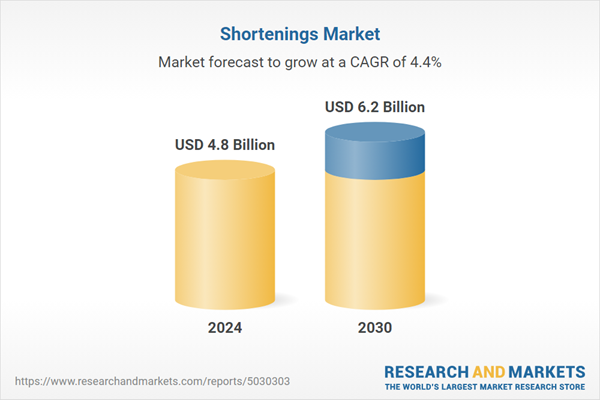The global market for Shortenings was valued at US$4.8 Billion in 2024 and is projected to reach US$6.2 Billion by 2030, growing at a CAGR of 4.4% from 2024 to 2030. This comprehensive report provides an in-depth analysis of market trends, drivers, and forecasts, helping you make informed business decisions. The report includes the most recent global tariff developments and how they impact the Shortenings market.
Segments: Key Ingredient (Oil, Butter, Lard, Tallow, Other Key Ingredients); Source (Vegetable, Animal); Variant (Solid, Liquid, All-Purpose, Other Variants); Application (Bakery, Confectionery, Snacks & Savory, Other Applications).
Geographic Regions/Countries: World; United States; Canada; Japan; China; Europe (France; Germany; Italy; United Kingdom; Spain; Russia; and Rest of Europe); Asia-Pacific (Australia; India; South Korea; and Rest of Asia-Pacific); Latin America (Argentina; Brazil; Mexico; and Rest of Latin America); Middle East (Iran; Israel; Saudi Arabia; United Arab Emirates; and Rest of Middle East); and Africa.
The analysts continuously track trade developments worldwide, drawing insights from leading global economists and over 200 industry and policy institutions, including think tanks, trade organizations, and national economic advisory bodies. This intelligence is integrated into forecasting models to provide timely, data-driven analysis of emerging risks and opportunities.
Global Shortenings Market - Key Trends and Drivers Summarized
Why Are Shortenings Vital in the Food Industry Today?
Shortenings play a crucial role in the food industry, particularly in baking and confectionery, due to their ability to create desirable textures, improve shelf life, and enhance flavors. Traditionally made from hydrogenated vegetable oils, shortenings are used in a variety of applications, including biscuits, cakes, pastries, and deep-fried foods. They provide the flakiness in pie crusts, the tenderness in cookies, and the lightness in cakes, making them indispensable for both home bakers and large-scale food processors. The demand for shortenings has remained robust, fueled by the growing consumption of baked goods and snack foods across the globe, especially in emerging markets where urbanization and changing lifestyles drive demand for convenient and ready-to-eat products.How Are Innovations in Shortening Formulations Impacting the Market?
Innovations in shortening formulations are significantly impacting the market by addressing health concerns and consumer preferences for natural and clean-label ingredients. The shift towards non-hydrogenated shortenings, which contain lower trans fats, is a direct response to the growing awareness about the health risks associated with trans fats and saturated fats. Producers are now focusing on developing plant-based, high-oleic, and specialty shortenings that provide the same functional benefits as traditional shortenings while aligning with consumer trends for healthier, vegan, and allergen-free products. Moreover, advancements in fat crystallization and emulsification technologies are enabling the development of shortenings that improve the texture, stability, and aeration in baked products, catering to the increasing demand for high-quality bakery items.Which Market Segments Are Driving the Growth of Shortenings?
Types of shortenings include all-purpose shortenings, emulsified shortenings, liquid shortenings, and specialty shortenings, with all-purpose and emulsified types being the most widely used due to their versatility in various cooking and baking processes. Applications span across bakery, confectionery, snacks, and dairy products, with the bakery segment dominating the market due to the high consumption of bread, cakes, cookies, and pastries. End-users of shortenings include commercial bakeries, foodservice operators, and household consumers, with commercial bakeries leading the market due to the scale of production and the need for consistent product quality. Asia-Pacific is emerging as a high-growth region driven by rising urbanization, changing dietary habits, and expanding bakery sectors.What Are the Key Drivers of Growth in the Shortenings Market?
The growth in the shortenings market is driven by several factors, including the rising demand for bakery and confectionery products, technological advancements in fat processing and emulsification, and the growing popularity of plant-based and non-hydrogenated shortenings. The development of specialty shortenings for gluten-free, organic, and clean-label products with improved functional properties for laminated dough, frying, and icing is driving market adoption among commercial bakeries, foodservice operators, and specialty food producers. The focus on enhancing shortening performance for stability, texture, and shelf-life is expanding the market reach among snack foods, frozen desserts, and ready-to-eat meals. The growing emphasis on sustainable and ethically sourced ingredients, coupled with increasing investments in R&D for zero-trans-fat, low-saturated-fat, and high-oleic shortenings, is creating new opportunities for market growth. Additionally, the rising use of shortenings in emerging markets with growing urbanization and consumer preferences is further supporting market expansion.Report Scope
The report analyzes the Shortenings market, presented in terms of units. The analysis covers the key segments and geographic regions outlined below.Segments: Key Ingredient (Oil, Butter, Lard, Tallow, Other Key Ingredients); Source (Vegetable, Animal); Variant (Solid, Liquid, All-Purpose, Other Variants); Application (Bakery, Confectionery, Snacks & Savory, Other Applications).
Geographic Regions/Countries: World; United States; Canada; Japan; China; Europe (France; Germany; Italy; United Kingdom; Spain; Russia; and Rest of Europe); Asia-Pacific (Australia; India; South Korea; and Rest of Asia-Pacific); Latin America (Argentina; Brazil; Mexico; and Rest of Latin America); Middle East (Iran; Israel; Saudi Arabia; United Arab Emirates; and Rest of Middle East); and Africa.
Key Insights:
- Market Growth: Understand the significant growth trajectory of the Oil segment, which is expected to reach US$2.2 Billion by 2030 with a CAGR of a 4.9%. The Butter segment is also set to grow at 4.4% CAGR over the analysis period.
- Regional Analysis: Gain insights into the U.S. market, valued at $1.3 Billion in 2024, and China, forecasted to grow at an impressive 7.2% CAGR to reach $1.3 Billion by 2030. Discover growth trends in other key regions, including Japan, Canada, Germany, and the Asia-Pacific.
Why You Should Buy This Report:
- Detailed Market Analysis: Access a thorough analysis of the Global Shortenings Market, covering all major geographic regions and market segments.
- Competitive Insights: Get an overview of the competitive landscape, including the market presence of major players across different geographies.
- Future Trends and Drivers: Understand the key trends and drivers shaping the future of the Global Shortenings Market.
- Actionable Insights: Benefit from actionable insights that can help you identify new revenue opportunities and make strategic business decisions.
Key Questions Answered:
- How is the Global Shortenings Market expected to evolve by 2030?
- What are the main drivers and restraints affecting the market?
- Which market segments will grow the most over the forecast period?
- How will market shares for different regions and segments change by 2030?
- Who are the leading players in the market, and what are their prospects?
Report Features:
- Comprehensive Market Data: Independent analysis of annual sales and market forecasts in US$ Million from 2024 to 2030.
- In-Depth Regional Analysis: Detailed insights into key markets, including the U.S., China, Japan, Canada, Europe, Asia-Pacific, Latin America, Middle East, and Africa.
- Company Profiles: Coverage of players such as AAK AB, Archer Daniels Midland Company, Associated British Foods PLC, Bunge Ltd., Cargill, Inc. and more.
- Complimentary Updates: Receive free report updates for one year to keep you informed of the latest market developments.
Some of the 42 companies featured in this Shortenings market report include:
- AAK AB
- Archer Daniels Midland Company
- Associated British Foods PLC
- Bunge Ltd.
- Cargill, Inc.
- Conagra Brands, Inc.
- International Foodstuff Company Holdings Limited (IFFCO)
- Manildra Group
- Ventura Foods, LLC.
- Wilmar International Ltd.
Tariff Impact Analysis: Key Insights for 2025
Global tariff negotiations across 180+ countries are reshaping supply chains, costs, and competitiveness. This report reflects the latest developments as of April 2025 and incorporates forward-looking insights into the market outlook.The analysts continuously track trade developments worldwide, drawing insights from leading global economists and over 200 industry and policy institutions, including think tanks, trade organizations, and national economic advisory bodies. This intelligence is integrated into forecasting models to provide timely, data-driven analysis of emerging risks and opportunities.
What’s Included in This Edition:
- Tariff-adjusted market forecasts by region and segment
- Analysis of cost and supply chain implications by sourcing and trade exposure
- Strategic insights into geographic shifts
Buyers receive a free July 2025 update with:
- Finalized tariff impacts and new trade agreement effects
- Updated projections reflecting global sourcing and cost shifts
- Expanded country-specific coverage across the industry
Table of Contents
I. METHODOLOGYII. EXECUTIVE SUMMARY2. FOCUS ON SELECT PLAYERSIII. MARKET ANALYSISCANADAITALYSPAINRUSSIAREST OF EUROPESOUTH KOREAREST OF ASIA-PACIFICARGENTINABRAZILMEXICOREST OF LATIN AMERICAIRANISRAELSAUDI ARABIAUNITED ARAB EMIRATESREST OF MIDDLE EASTIV. COMPETITION
1. MARKET OVERVIEW
3. MARKET TRENDS & DRIVERS
4. GLOBAL MARKET PERSPECTIVE
UNITED STATES
JAPAN
CHINA
EUROPE
FRANCE
GERMANY
UNITED KINGDOM
ASIA-PACIFIC
AUSTRALIA
INDIA
LATIN AMERICA
MIDDLE EAST
AFRICA
Companies Mentioned (Partial List)
A selection of companies mentioned in this report includes, but is not limited to:
- AAK AB
- Archer Daniels Midland Company
- Associated British Foods PLC
- Bunge Ltd.
- Cargill, Inc.
- Conagra Brands, Inc.
- International Foodstuff Company Holdings Limited (IFFCO)
- Manildra Group
- Ventura Foods, LLC.
- Wilmar International Ltd.
Table Information
| Report Attribute | Details |
|---|---|
| No. of Pages | 323 |
| Published | April 2025 |
| Forecast Period | 2024 - 2030 |
| Estimated Market Value ( USD | $ 4.8 Billion |
| Forecasted Market Value ( USD | $ 6.2 Billion |
| Compound Annual Growth Rate | 4.4% |
| Regions Covered | Global |









